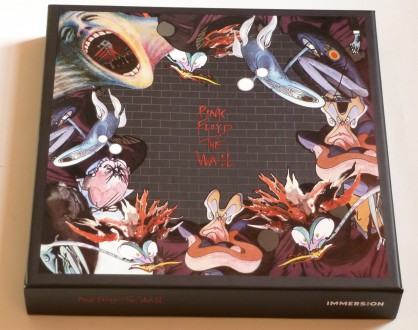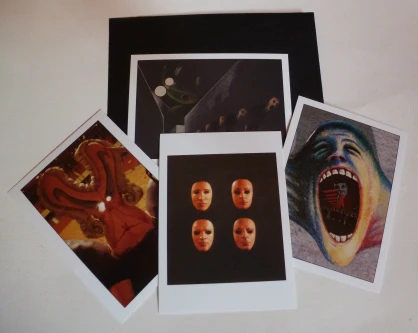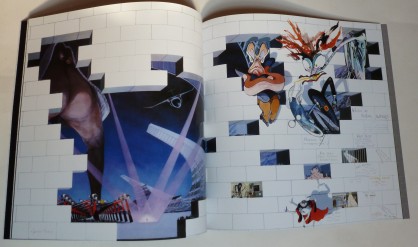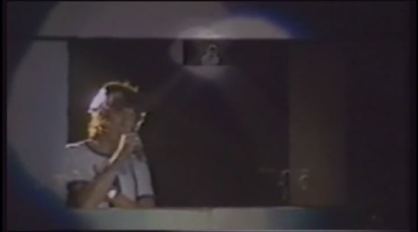I first heard Pink Floyd’s 1979 double album the Wall sometime in 1984, as a 12-year-old boy. A neighbor at my apartment building loaned me a cassette version, and I played it through only once, before going to bed. That night, after climbing under the sheets in the bottom bunk of the bed I shared with my little brother, I suffered a nightmare. I no longer remember what I dreamt, but I knew I had experienced the Wall’s honest, primal power even though I could barely understand what was going on in the “narrative” of this concept album. I would not go back to listen to it again until about five years later.
In the years since, I have covered Pink Floyd reissues and books as a freelance music writer, often in the pages of the record collector’s magazine, “Goldmine.” I personally enjoyed owning the Shine On CD box set in 1992, which included the full Wall album, after saving up some money as a poor college student. A friend who worked at a record store would help me out with his employee discount.  I have seen Alan Parker’s film version of the album, conceived with the Wall’s principal songwriter, Roger Waters on VHS. I own the first edition DVD version and have watched it several times since, even with commentary. I also reviewed Water’s staging of the album in Berlin when a DVD of the show came out in 2003, for “Goldmine.” I have grown to know the album well, and though it no longer frightens me, its punch remains and probably always will.
I have seen Alan Parker’s film version of the album, conceived with the Wall’s principal songwriter, Roger Waters on VHS. I own the first edition DVD version and have watched it several times since, even with commentary. I also reviewed Water’s staging of the album in Berlin when a DVD of the show came out in 2003, for “Goldmine.” I have grown to know the album well, and though it no longer frightens me, its punch remains and probably always will.
Though the album is known for furthering the rift between Waters and his collaborators in Pink Floyd, I have always found an almost auterist benefit to Waters handling the majority of the songwriting for the Wall. The album seems to chronicle the mental breakdown of a rock ‘n’ roll star who tangles with his sense of self in the wake of his fame. Sex (“Young Lust”) and drugs (“Comfortably Numb”) were never depicted more bleakly on a rock ‘n’ roll record. It was honest and genuine, and Waters dives deep, going back to growing up fatherless thanks to World War II (“Goodbye Blue Sky”). He examines the role of a smothering mother (“Mother” and “The Trial”) and domineering boarding school education (“Another Brick in the Wall, Part 2”). The references to a wall throughout the album provide a metaphor about the gradual psychological isolation of the protagonist to the outside world. The only cure? “Tear down the Wall,” chants a mob at the end of the next-to-last track of the album. Chronicling a dynamic, if gloomy journey into isolation, the album produced some of the band’s greatest hits like the aforementioned “Comfortably Numb” and “Another Brick in the Wall, Part 2.” The music is grim and potent throughout, until a wonderful, if subtle shift in tone at album’s end. “Outside the Wall” is an underrated number that illuminates and subverts all the tracks that unfolded before it. It truly sounds like hope (though “it’s not easy”). All the self-important, if self-critical posing, both ironic and bombastic, is over. There is no more spectacle to be seen here. There’s a mellowness in Waters’ voice joined by a harmonious chorus of other voices. The rock elements are gone, as the main instrument is clarinet, augmented by the high-pitched hum of a droning accordion and sprightly strum of a mandolin. It makes for an ingenious tonal shift that offers an often-overlooked turnaround, not to mention a bright sense of hope to the mostly gloomy album.
The references to a wall throughout the album provide a metaphor about the gradual psychological isolation of the protagonist to the outside world. The only cure? “Tear down the Wall,” chants a mob at the end of the next-to-last track of the album. Chronicling a dynamic, if gloomy journey into isolation, the album produced some of the band’s greatest hits like the aforementioned “Comfortably Numb” and “Another Brick in the Wall, Part 2.” The music is grim and potent throughout, until a wonderful, if subtle shift in tone at album’s end. “Outside the Wall” is an underrated number that illuminates and subverts all the tracks that unfolded before it. It truly sounds like hope (though “it’s not easy”). All the self-important, if self-critical posing, both ironic and bombastic, is over. There is no more spectacle to be seen here. There’s a mellowness in Waters’ voice joined by a harmonious chorus of other voices. The rock elements are gone, as the main instrument is clarinet, augmented by the high-pitched hum of a droning accordion and sprightly strum of a mandolin. It makes for an ingenious tonal shift that offers an often-overlooked turnaround, not to mention a bright sense of hope to the mostly gloomy album.
The Wall Immersion set contents
(clicking on images below will give you a hi-res view)
The Wall is a true masterpiece of rock concept albums. It is the sole, intensive “Immersion” box set of the recent Pink Floyd reissues by EMI I was interested in owning because I was real curious about what else went into making this album (all those demos!). EMI Records was generous enough to offer me a review copy for an intensive look at the extras packed inside the box that sells at a suggested retail price of just over $100. The price is justified by lots of physical elements, the most bizarre of which includes a velvet bag of three white marbles with the lined pattern of bricks familiar to anyone who has seen the album’s cover (a reference to “They must have taken all my marbles away”?).
The lines on the marbles arrived a bit broken up and worn, so whatever paint used was not the right quality for lasting handling (A tiny slip of paper inserted among them says “Glass Marbles Made in China”). They also are not perfectly round with some indentations on the surface. Also among the weirder items included in the box: a fringed gray scarf with the Wall pattern and the marching hammer logo printed at each edge.
It looks a bit cheap and marks a fashion trend that has passed on most hip men and was probably never in fashion for the hardcore Pink Floyd fan this set is designed for. Maybe someone’s wife would like it? There is also a set of cheap cardboard coasters that spell out the band’s name.
Beyond the coasters, the paper items are a bit more interesting. There are three black paper envelopes of varying sizes. The one marked “memorabilia” includes a replica backstage pass to a Wall show at the Nassau Coliseum, February 26, 1980. There is also a full-color, embossed ticket for a show in Berlin.
Another envelope is labeled “collector’s cards,” which contained four cards with pictures that are also in the books enclosed with this set. On the reverse side of the image there is text, and they are numbered various numbers out of 57. The text side has a song title and part of the lyrics oriented with the image on the reverse side.
The text side also refers to the cards as “anti-cigarette cards” because, apparently, cigarette packs back in the day of this album’s original release would come with such cards as added incentive for smokers. The view on smoking nowadays has changed much in the years since these cards first emerged. Now, these cards can apparently be found in various Pink Floyd products.
The third envelope is labeled “Mark Fisher Cards” and contains larger-formatted, one-sided cards of sketches depicting the stage design of the Wall show by Mark Fisher.
Other paper stuffs include an art print of an illustration of “the Wife” by Gerald Scarfe from the art he designed for both the inside of the album and the stage show (the creature below would later be created as a giant blow-up puppet with light-up neon lips and eyes).
There is also a folded up giant-sized poster with the lyrics of all the songs on the album, written out in the same ferocious script Scarfe used as the original lyric sheet of the album.
Finally there are two soft-covered booklets and a pamphlet with song titles for every disc enclosed and credits to the engineers, designers and musicians involved.
The larger of the books, simply titled “Pink Floyd The Wall,” contains photographs of the band during the Wall show, as well as the set pieces, behind-the-scenes images, sketches by Fisher and Scarfe and the lyrics as designed by Scarfe. The layout was conceived by Storm Thorgerson whose Hipgnosis studios had a longtime working relationship with Pink Floyd up until the Wall.
The other, slightly smaller, book titled “The Wall Pink Floyd Circa 1980-1 Booklet For The Immersion Box Set” contains nothing but photos of Pink Floyd during the Wall show circa— of course— 1980 and 1981. This one is edited by one of the photographers involved: Jill Furmanovsky. There are no essays or interviews at all in these books, however. Taking that into consideration, the books enclosed in the Wall Immersion set only deserve a fraction of attention that the thick, hardcover book I remember from the Shine On box set warranted*. There is nothing to really read or absorb beyond the lyrics and photos. The Wall Immersion booklet does have an interesting back cover image and brief essay showing the reach of the band into the war-torn country of Sarajevo in 1999:
I would have liked further essays with longer, more in-depth analysis of the album or its conception. Though the plethora of period pictures of the band performing the Wall in both the Immersion booklet and the Wall booklet are nice at capturing this particular moment of Floyd’s career, they beg for some context beyond the album’s lyrics and credits. The glossy paper is of fine quality and will certainly offer an upgrade to any other inserts in any other version of this album and lyrics from the album, but they deserved a little more attention by the design team.
The true substance of the box appears in the seven discs enclosed in— of all things— individual cardboard sleeves.  I am sure I speak for many collectors when I protest the use of cardboard sleeves without any protection to the discs, so allow me one more complaint. Japanese releases in cardboard sleeves always come in scratch-preventive plastic sleeves. OK, so there is one tray in this box, below all the ephemera, with cardboard hubs designed to hold four of the discs. Still, for the price tag of this set, plastic trays that prevent the play surfaces from any physical
I am sure I speak for many collectors when I protest the use of cardboard sleeves without any protection to the discs, so allow me one more complaint. Japanese releases in cardboard sleeves always come in scratch-preventive plastic sleeves. OK, so there is one tray in this box, below all the ephemera, with cardboard hubs designed to hold four of the discs. Still, for the price tag of this set, plastic trays that prevent the play surfaces from any physical  contact could have easily been used instead of all this cardboard, which can scratch play surfaces and attract moisture.
contact could have easily been used instead of all this cardboard, which can scratch play surfaces and attract moisture.
That said, I have long let go of any illusions that CDs or even LPs will last “forever” when treated with care, so I am not too bothered by the quality of the design. Still, I want to speak for some of the more serious collectors out there. But also, to address the serious collectors, I handle all of my CDs and records with as much care as possible, but I know I will be long dead before the elements seriously degrade them or I’m just plain over them and another reissue comes down the pike. I still have the beat up copy of the hardback book that came in the Shine On box set. The outer box grew so worn, I decided to throw it out and pack the CDs on my shelf, showing of the Darkside of the Moon cover art pattern that appears on the black CD jewel cases’ spines:
The Wall CDs
Finally, on to the music. Though the art on the labels have been redesigned for the box set, the audio on the two Wall CDs features the same remaster work by the band’s longtime engineer James Guthrie and Joel Plante, released last year as part of EMI’s 2011 remaster campaign of the entire Floyd catalog.  I have already reflected on the terrific remastering job of these albums, including the Wall (As Pink Floyd reissue mania continues, allow me a few words on said band), one of the major highlights being the clarity in the vocals. These new mixes allow the singers’ words to pop out without disturbing the original mix. I think purists have complained of nit-picky details, but seriously, nothing super-altered has emerged. This was not George Lucas going into the original Star Wars and adding whole scenes with digital cartoons or altering characters à la Han-shoots-first. This is a faithful polishing job that does fair justice to the source material.
I have already reflected on the terrific remastering job of these albums, including the Wall (As Pink Floyd reissue mania continues, allow me a few words on said band), one of the major highlights being the clarity in the vocals. These new mixes allow the singers’ words to pop out without disturbing the original mix. I think purists have complained of nit-picky details, but seriously, nothing super-altered has emerged. This was not George Lucas going into the original Star Wars and adding whole scenes with digital cartoons or altering characters à la Han-shoots-first. This is a faithful polishing job that does fair justice to the source material.
The live CDs
Besides the remastering of the classic album, Guthrie and Plante went to work resurrecting Is There Anybody Out There? a full-length concert performance of the Wall recorded over the course of the band’s brief Wall tour in 1980-81. Any true Pink Floyd fan would most likely already own the original version, released as both a 2-CD set and a deluxe edition with a hardback book, in 2000.
It’s a well-known live album compiled from various shows of the original tour but still following the order of songs on the Wall. The differences in the songs from the original album should prove of interest to any fan with a close knowledge of the Wall.
Is There Anybody Out There? opens with an announcer typical of many live shows in the day. He says, “…Before the show begins the house management would like to request just a few things. First, please no fireworks…” as the sound of the musicians warming up starts to drown out part of the speech (for a split second, it almost sounds as if the band is gearing up to play “One of Theses Days,” the opening track to Meddle).  Just as he finishes, “Well, I think the band’s ready to go now … no, no. Not quite yet. One thing I would like to point out, upon conclusion of the show…” the band pounds the man’s voice into oblivion with booming intro of “In the Flesh?”. It offers a great stage set-up to the fact that this is the performance of a concept album chronicling the psychic unraveling of a rock star poisoned by fame. In the years that have passed since 1981, this announcement sounds quaint, as security nowadays can do little to deter the pocket recorders not to mention smart phones most concertgoers bring to shows. More than ever, like it or not, the varying lights of smart phones and digital cameras seem part of a show. This amusing intro only heightens the classic feeling of this rock album that has well stood the test of time beyond the need of such announcements.
Just as he finishes, “Well, I think the band’s ready to go now … no, no. Not quite yet. One thing I would like to point out, upon conclusion of the show…” the band pounds the man’s voice into oblivion with booming intro of “In the Flesh?”. It offers a great stage set-up to the fact that this is the performance of a concept album chronicling the psychic unraveling of a rock star poisoned by fame. In the years that have passed since 1981, this announcement sounds quaint, as security nowadays can do little to deter the pocket recorders not to mention smart phones most concertgoers bring to shows. More than ever, like it or not, the varying lights of smart phones and digital cameras seem part of a show. This amusing intro only heightens the classic feeling of this rock album that has well stood the test of time beyond the need of such announcements.
The live album enforces the notion that Pink Floyd was more than just a creative studio band. 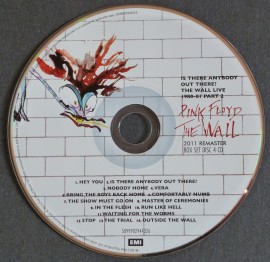 Their shows were amazing live experiences, even if they maintained a dedication to the original recordings, for the most part. Even though the band extends a few songs with meandering solos during Is There Anybody Out There?, the songs still cut close to the original recordings. “Mother” goes on for 7:55 thanks to some particularly passionate indulgence the original version does not have. The first CD ends with an instrumental overture called “The Last Few Bricks” featuring themes from many of the album. It worked as a musical interlude so stage hands might complete adding “the last few bricks” to the large, white wall, which covered the band for most of the second half of the show. Though this wall obscured the band for much of the show, it offers a poetic touch that reinforced the band members as faceless artists and not pop rock idols who needed spotlights shining on them. They were from a time and a genre that preferred anonymity and wanted only the music to matter.
Their shows were amazing live experiences, even if they maintained a dedication to the original recordings, for the most part. Even though the band extends a few songs with meandering solos during Is There Anybody Out There?, the songs still cut close to the original recordings. “Mother” goes on for 7:55 thanks to some particularly passionate indulgence the original version does not have. The first CD ends with an instrumental overture called “The Last Few Bricks” featuring themes from many of the album. It worked as a musical interlude so stage hands might complete adding “the last few bricks” to the large, white wall, which covered the band for most of the second half of the show. Though this wall obscured the band for much of the show, it offers a poetic touch that reinforced the band members as faceless artists and not pop rock idols who needed spotlights shining on them. They were from a time and a genre that preferred anonymity and wanted only the music to matter.
The DVD
The seventh disc is a DVD, which is coded for all regions, though in the NTSC format. It features lots of fantastic archival footage of the band’s live shows in the early eighties, culled together for a 50-minute documentary put together in 2000 by EMI called Behind the Wall.  It features interviews with the band members and narration that explains what was happening in and around the band at the time. There is also a nice detour into what happened before their pinnacle of fame, leading up to the live production of the Wall. Waters talks about his growing disdain for the sort of rock ‘n’ roll stadium audience whose participants just jumped on the bandwagon of popular trends or what was hot on the pop charts, following it to the venue. He says this is why he conceived the Wall. He truly wanted to separate the band from the audience and build a huge wall on stage that the band could play behind. He addresses a famous incident he seems a bit ashamed of in retrospect where he spit on a kid pushing his way toward the stage. “Afterwards I became really depressed and thought, ‘My God, what have I been reduced to?'” he says.
It features interviews with the band members and narration that explains what was happening in and around the band at the time. There is also a nice detour into what happened before their pinnacle of fame, leading up to the live production of the Wall. Waters talks about his growing disdain for the sort of rock ‘n’ roll stadium audience whose participants just jumped on the bandwagon of popular trends or what was hot on the pop charts, following it to the venue. He says this is why he conceived the Wall. He truly wanted to separate the band from the audience and build a huge wall on stage that the band could play behind. He addresses a famous incident he seems a bit ashamed of in retrospect where he spit on a kid pushing his way toward the stage. “Afterwards I became really depressed and thought, ‘My God, what have I been reduced to?'” he says.
Besides insightful commentary from all band members, including the late keyboardist Rick Wright, the program features lots of fantastic professionally shot live footage of the band during some of only 29 shows they performed of the Wall. The few clips that appear are so well done, with multiple cameras, it makes you long for a full, live filmed performance. The band have often said that not enough of this quality footage exists to make a full, proper live concert video, however (Note: the image below is not representative of the picture quality on the DVD included in the Wall Immersion set, just on old still found from an earlier incarnation of the DVD, which has been remastered for this box set).
Though this is a DVD, many will be disappointed to learn there is no audio version of the album remastered into a 5.1 DVD surround mix. This feature was included in the only two other Immersion Pink Floyd reissues that have come out so far: the Dark Side of the Moon and Wish You Were Here. However, an interview with Pink Floyd drummer Nick Mason revealed a 5.1 mix for the Wall had been planned and may see the light of day in a future reissue.
Instead, Pink Floyd fans will have to settle with visual material many may already be familiar with, albeit restored and improved over any of its earlier incarnations in both video and sound quality. There is also a restored video of the band’s famous single “Another Brick in the Wall, Part 2” as well as a live performance of “the Happiest Days of Our Lives” that looks amazing with blue lens flares and multiple angles. The video comes to a stop just as the giant teacher puppet appears, however, fading out as Waters sings “We don’t need no education…” making for quite a cruel tease.
Finally, also on the disc is an extended interview with Scarfe from the Behind the Wall documentary and for Getty Images. It goes on for about 17 minutes and has some overlap with Behind the Wall, but features footage otherwise never released officially.
It is mostly him as a talking head with a few cutaway shots to his drawings. He talks about how his creative process with Waters and other animators, often in a long uncut monologue. There is also a nice moment when he stands next to a portfolio and explains some of his Wall illustrations, which were later turned into film sequences projected during the live show and then wound up in Parker’s film version.
The Demo CDs
Finally, the moment most of the hardcore fans of the Wall probably most anticipated: the more than two hours worth of demos, spread across two CDs included in this set, entitled “Work in Progress – Part 1 and 2 [respectively], 1979.” The sleeves of both discs feature “A word about the content of these ‘demo’ discs” written by Guthrie. He explains that Waters had produced “about 3 album’s worth of material,” only 14 minutes of which appear on these discs, he however notes. The rest are much fuller band demos trying to sketch out the running order of the album.
Considering the amount of demos and the redundancies here, I cannot harshly pass judgment on what is or is not included. I do not envy those tasked with weeding through the demos, sequencing them and putting them together into the interesting collages that fill the two discs included here, and they are interesting.
Disc 5 has a total runtime of 71:21. Programme 1, composed of the Waters demos, feels like a cruel teaser, as the tracks offer only a fraction of what were the first kernels of the Wall.  These 22 tracks, for the most part, fade away before they barely start. Some are as short as 19 seconds and definitely sound like they last longer, even though they may not be complete songs. They mostly feature Waters strumming an acoustic guitar with some effects thrown in here and there with snippets of him singing variations of lyrics that ultimately ended up on the Wall. There are some definite odd differences like the lyrics of “Another Brick in the Wall, Part 2:” “I don’t need no education/I don’t need no rising water.” Hearing “Run Like Hell” as first conceived by Waters reveals a completely different idea until guitarist/vocalist David Gilmour had his input. The song sways in an almost country manner and had lyrics like, “You better run like hell if you wanna get away from here.” “What Shall We Do Now?” was first known as “Backs to the Wall” but included lyrics that did not change much at all, on the other hand.
These 22 tracks, for the most part, fade away before they barely start. Some are as short as 19 seconds and definitely sound like they last longer, even though they may not be complete songs. They mostly feature Waters strumming an acoustic guitar with some effects thrown in here and there with snippets of him singing variations of lyrics that ultimately ended up on the Wall. There are some definite odd differences like the lyrics of “Another Brick in the Wall, Part 2:” “I don’t need no education/I don’t need no rising water.” Hearing “Run Like Hell” as first conceived by Waters reveals a completely different idea until guitarist/vocalist David Gilmour had his input. The song sways in an almost country manner and had lyrics like, “You better run like hell if you wanna get away from here.” “What Shall We Do Now?” was first known as “Backs to the Wall” but included lyrics that did not change much at all, on the other hand.
By the time Programme 2 starts, things grow even more interesting. This “programme” marks the start of the band demos, and they contain complete songs, including some that never wound up on the Wall or even changed completely into other songs on the album. One of these songs is “Teacher, Teacher,” a bright little tune that seems just a bit lighter than the rest of the music that wound up in the album. It’s an airy piece with an awkward shift into a chorus that seemed destined to the outtakes archive. Then there is the bluesy, meandering “Sexual Revolution” that runs out of words and momentum halfway through its five-minute runtime. Some of these demos rise above curious experiments, however. “In the Flesh” has a nice extended intro, featuring a quiet, acoustic guitar breakdown and distant moaning. Though the drums pop like gunshots, it loses some punch and fades away at the end.
The demos reveal the members of Pink Floyd as a band deeply involved in experimentation open to exploring ideas while refining their way to a masterpiece. The attention to detail throughout is impressive. Toward the end of the Disc 5, during Programme 3, a hint of the start of the album is offered, as the first six tracks of the album appear in sequential order, in rough demo form. The real concentrated power of the Wall now finally appears, though the recording quality is weak and some of the songs have been faded out and truncated. It ends with an incredible version of “Mother,” with added groans, screeches and sighs of synthesizers. It’s super-affected and weird with Gilmour going reverb crazy on bluesy electric guitar. Though not as moving as the spare album version most are familiar with, it carries a strange surreal— dare-I-say— druggy, psychedelic quality, as if a younger Pink Floyd were at work here.
At a runtime of 57:29, Disc 6 is shorter, but the demos are longer here, (though, once again, the music is not always complete). Programme 1 of this CD mixes both the Waters and the band demos. The first three tracks are Waters’ demos and reveals how much vision he had early in the process. 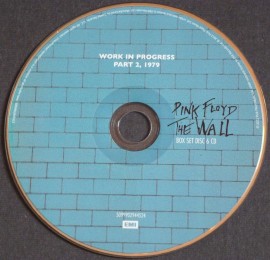 He uses many overdubs and even sings the bombastic drum part of “Bring the Boys Back Home.” The band demos begin with track four and an especially interesting, if over-the-top, version of “Hey You.” The dynamics are more intense than the final recording, as the band had yet to work out the song’s subtleties and add polish in the studio. “The Doctor,” later known as “Comfortably Numb,” opens very different from the final version, as Waters sings more literal lines before he toned the lyrics down for a more evocative quality. It again offers a great example of how fine-tuned the album came to be. There is a second version of “The Doctor (Comfortably Numb)” during Programme 2 of the disc where Gilmour sings all of the lyrics. You can tell the band was searching for something with this track, and these working versions, though fine in themselves, are testament to the detailed wringer the band put its creativity through. A name change to “Comfortably Numb” would make for a smart capper to the many tweaks the song later went through.
He uses many overdubs and even sings the bombastic drum part of “Bring the Boys Back Home.” The band demos begin with track four and an especially interesting, if over-the-top, version of “Hey You.” The dynamics are more intense than the final recording, as the band had yet to work out the song’s subtleties and add polish in the studio. “The Doctor,” later known as “Comfortably Numb,” opens very different from the final version, as Waters sings more literal lines before he toned the lyrics down for a more evocative quality. It again offers a great example of how fine-tuned the album came to be. There is a second version of “The Doctor (Comfortably Numb)” during Programme 2 of the disc where Gilmour sings all of the lyrics. You can tell the band was searching for something with this track, and these working versions, though fine in themselves, are testament to the detailed wringer the band put its creativity through. A name change to “Comfortably Numb” would make for a smart capper to the many tweaks the song later went through.
The songs on the second “Work in Progress” disc are also more distinctive. “Run Like Hell” features guitars that sound so crystalline they practically sparkle. The echo is so luscious at times it sounds as if they are playing the music under water. You can just hear Waters and Gilmour grooving along for the sake of indulging in this exaggerated sound effect. It fades away before it gets too indulgent, though, and it sill makes for a treat, nonetheless. Many of the demos on this disc have a sheen that sounds more produced than the previous demo disc. Sometimes it’s too a fault. “One of My Turns” goes off grooving on an organ down a terrible street as Waters’ singing falls embarrassingly out of synch.
Finally, the second demo disc wraps with Gilmour’s slight contributions. He sings “do-dos” mapping out the lyric structure of “Comfortably Numb” on a dreamily affected acoustic guitar, and then there is an electric, wah-wah instrumental version of “Run Like Hell.” The two tracks provide not only clear insight into how he participated in the songwriting versus Waters but also how important these slight but essential contributions were to a couple of album highlights.
Final thoughts
With Independent Ethos, I do not just limit myself to obscure titles, artists or films, though it often might seem so. There are many popular works out there that come from a creative, personal space, and this fancy box set thoroughly explores one of the most iconic progressive rock albums that ever did indeed come from such a space. Despite all the trinkets and extras that seem to pad this “immersion” experience of the Wall, the truly exciting aspect of this box lies within its music and its treatment. Even the visuals come after the music. There are seven discs included here, but it’s barely enough to contain all the interesting aspects of Pink Floyd’s 1979 double album. The music alone, but also the picture books, were enough to throw me back to a time when this album just came out. I may have been a kid in elementary school, but the presence of the album in popular music already made an impression in my mind.
Though I was too young to enjoy the original tour of the Wall in 1980-81, I do count myself among many that have seen Roger Waters’ recent live show of the full album (Waters’ ‘the Wall’ live cements theme with vivid production). Last month, Waters once gain came to the same venue in my area for another one of these shows, and this time I reviewed it for “County Grind,” one of the blogs on the “Broward/Palm Beach New Times” website. This time, they secured a pair of tickets for me, and I had a view from the floor. You can read that review and see lots of close-up pictures by jumping through the following photo taken of Waters at the show:
The tour continues as I post this long-in-the-works blog post (pardon the length), including stops at larger stadiums than this tour was ever first designed for. Visit Roger Waters’ website for the remaining tour dates. Finally, the Wall Immersion set is available at most stores. If you purchase it through Amazon via this link, you will be supporting this blog with a commission provided by Amazon at no extra charge to you.
*The Shine On box set was designed by Thorgerson.
